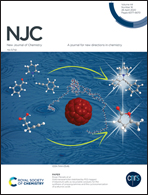A squaraine-based dipicolylamine derivative acting as a turn-on mercury(ii) fluorescent probe in water†
Abstract
A symmetrical squaraine-based ligand, sbdpa, bearing two dipicolylamine (dpa) units, was synthesized for the first time, using an environment friendly procedure, such as one-pot and solvent-free reaction. The sbdpa ligand was found to have a small blue-green emission, in aqueous solution, due to a photoinduced electron transfer (PET) mechanism. Metal complexes of sbdpa with a large panel of cations, Na+, K+, Ag+, Mg2+, Ca2+, Ba2+, Mn2+, Fe2+, Co2+, Ni2+, Cu2+, Zn2+, Cd2+, Hg2+, and Pb2+, were prepared in aqueous buffered solution and screened, in search of a selective response for one of them. A turn-on fluorescence response was then found only for Hg2+, as a consequence of a chelation-enhanced fluorescence (CHEF) effect that disrupts the PET mechanism in sbdpa. Subsequently, the complexation behaviour of Hg2+ with sbdpa was investigated in aqueous solution by potentiometric titrations and other spectroscopic techniques. The acid–base reactions of the ligand were also studied by potentiometry, as well as by 1H-NMR and UV-vis titrations. For comparison purposes, the complexation of two other divalent cations, Cu2+ and Zn2+, was also assessed by potentiometry. Additionally, results are compared with dpa all along the study. Both mono- and dinuclear complexes of sbdpa were found for the three metal cations studied the mercury(II) complex having the largest thermodynamic stability. These findings support a stronger uptake of Hg2+ cation by sbdpa, possibly involving at least one oxygen atom from the squaraine moiety on its coordination sphere.



 Please wait while we load your content...
Please wait while we load your content...